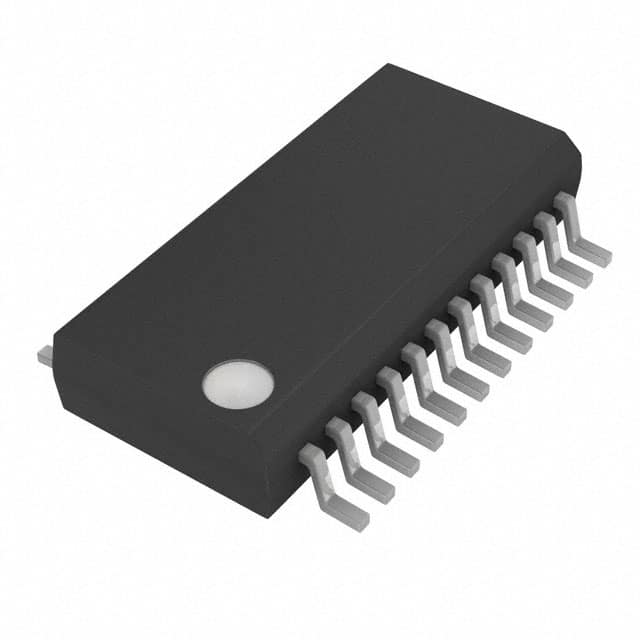TLC5948DBQR
Product Overview
Category
TLC5948DBQR belongs to the category of integrated circuits (ICs).
Use
This IC is commonly used for driving LEDs (Light Emitting Diodes) in various applications.
Characteristics
- TLC5948DBQR is a 16-channel constant current LED driver.
- It operates with a supply voltage range of 3V to 5.5V.
- The device has a grayscale PWM (Pulse Width Modulation) control, allowing precise control over LED brightness levels.
- It supports a maximum output current of 120 mA per channel.
- The IC offers a high refresh rate, enabling smooth and flicker-free LED animations.
Package
TLC5948DBQR comes in a small-sized SSOP (Shrink Small Outline Package) package.
Essence
The essence of TLC5948DBQR lies in its ability to efficiently drive multiple LEDs with individual control over their brightness levels.
Packaging/Quantity
This IC is typically available in reels containing a quantity of 2500 units.
Specifications
- Supply Voltage Range: 3V to 5.5V
- Maximum Output Current: 120 mA per channel
- Number of Channels: 16
- Grayscale Control: 4096 steps
- Refresh Rate: Up to 30 kHz
- Package Type: SSOP-24
Detailed Pin Configuration
- VCC - Power supply voltage
- GND - Ground reference
- SIN - Serial data input
- SCLK - Serial clock input
- XLAT - Latch signal input
- BLANK - Output enable signal input
- DCPRG - Dot correction programming input
- GSCLK - Grayscale clock input 9-24. OUT0-OUT15 - Constant current outputs for driving LEDs
Functional Features
- High grayscale control: TLC5948DBQR provides 4096 steps of grayscale control, allowing precise adjustment of LED brightness levels.
- Dot correction: The IC supports dot correction programming, enabling compensation for LED intensity variations.
- Daisy-chainable: Multiple TLC5948DBQR ICs can be daisy-chained to drive a larger number of LEDs with synchronized control.
- Error detection: The device incorporates error detection circuitry to identify and report any fault conditions.
Advantages and Disadvantages
Advantages
- Precise control over LED brightness levels
- High refresh rate for smooth animations
- Dot correction feature compensates for LED intensity variations
- Daisy-chainable for scalability
- Error detection ensures reliable operation
Disadvantages
- Limited to driving LEDs and not suitable for other applications
- Requires external components for proper operation
Working Principles
TLC5948DBQR operates by receiving serial data input (SIN) and clock input (SCLK) to control the grayscale levels of each LED channel. The grayscale data is latched using the XLAT signal, and the output enable (BLANK) signal determines whether the LEDs are on or off. The GSCLK signal controls the grayscale clock, which determines the refresh rate of the LEDs.
Detailed Application Field Plans
TLC5948DBQR finds applications in various fields, including: 1. LED displays and signage 2. Automotive lighting systems 3. Architectural lighting 4. Entertainment and stage lighting 5. Consumer electronics 6. Industrial control panels
Detailed and Complete Alternative Models
- TLC5947: Similar to TLC5948DBQR but with 24 channels instead of 16.
- MAX7219: LED driver IC with serial interface and multiplexing capabilities.
- TLC59711: 12-channel constant current LED driver with built-in PWM control.
These alternative models offer similar functionality and can be considered as substitutes for TLC5948DBQR in different applications.
Word count: 527 words
Lista 10 Vanliga frågor och svar relaterade till tillämpningen av TLC5948DBQR i tekniska lösningar
Sure! Here are 10 common questions and answers related to the application of TLC5948DBQR:
Q: What is the TLC5948DBQR? A: The TLC5948DBQR is a 16-channel, constant-current sink LED driver that can be used in various applications requiring precise control over multiple LEDs.
Q: What is the maximum current output per channel? A: The TLC5948DBQR can provide a maximum current output of 120 mA per channel.
Q: Can I use the TLC5948DBQR with different types of LEDs? A: Yes, the TLC5948DBQR can be used with various types of LEDs, including common cathode RGB LEDs, single-color LEDs, and even high-power LEDs.
Q: How many TLC5948DBQR chips can be daisy-chained together? A: Multiple TLC5948DBQR chips can be daisy-chained together to control a larger number of LEDs. Up to 12 chips can be connected in series.
Q: What is the communication interface used by the TLC5948DBQR? A: The TLC5948DBQR uses a serial interface called SPI (Serial Peripheral Interface) for communication with a microcontroller or other devices.
Q: Can the TLC5948DBQR handle dimming and fading effects for LEDs? A: Yes, the TLC5948DBQR supports grayscale PWM (Pulse Width Modulation), allowing smooth dimming and fading effects for individual LEDs.
Q: What is the supply voltage range for the TLC5948DBQR? A: The TLC5948DBQR operates with a supply voltage range of 3 V to 5.5 V.
Q: Does the TLC5948DBQR have built-in thermal shutdown protection? A: Yes, the TLC5948DBQR includes a thermal shutdown feature that protects the chip from overheating.
Q: Can I use the TLC5948DBQR in automotive applications? A: Yes, the TLC5948DBQR is suitable for automotive applications as it can operate within the required temperature range and has ESD protection.
Q: Are there any evaluation boards or reference designs available for the TLC5948DBQR? A: Yes, Texas Instruments provides evaluation boards and reference designs that can help users quickly prototype and implement solutions using the TLC5948DBQR.
Please note that these answers are general and may vary depending on specific application requirements and datasheet specifications.


